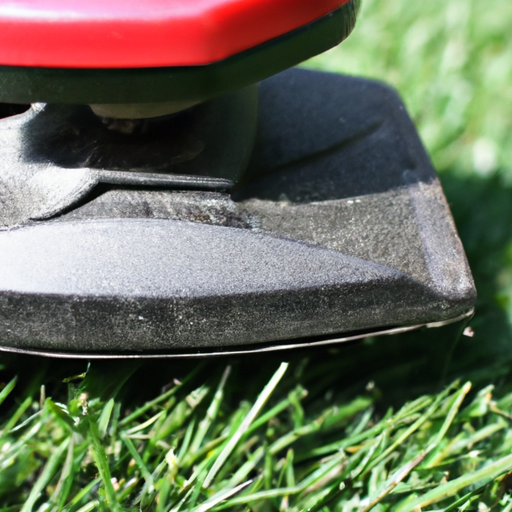If you want your lawn to always look flawless, then it’s essential to keep your lawn mower blades sharp and in top condition. A dull blade can leave your grass looking ragged, uneven, and promote the growth of diseases. But don’t worry, sharpening your lawn mower blades is easier than you may think. In this article, you’ll discover some effective tips that will keep your blades sharp and guarantee a nicely manicured lawn every time you mow.
Choosing the Right Time to Sharpen
Frequency of sharpening
When it comes to maintaining a healthy and lush-looking lawn, one of the most important tasks is to ensure that your lawn mower blades are in top-notch condition. The frequency at which you should sharpen your blades depends on several factors, such as the size of your lawn, the type of grass you have, and how often you mow. As a general rule of thumb, it is recommended to sharpen the blades at least once every season or approximately every 20-25 hours of use. This will help you achieve a clean, even cut and prevent your grass from appearing ragged or browned.
Signs that your blades need sharpening
If you’re unsure whether it’s time to sharpen your lawn mower blades, there are a few telltale signs to look out for. First and foremost, pay attention to the quality of your lawn after mowing. Are you noticing uneven patches of grass or a torn appearance? These are signs that your blades may be dull and in need of sharpening. Additionally, if you find yourself having to make multiple passes over the same area to achieve a satisfactory result, this could also indicate that your blades are no longer sharp enough. A visual inspection of the blades may also reveal nicks, chips, or a dull, rounded edge, all of which are clear indicators that it’s time to sharpen them.
Preparation for Sharpening
Gather necessary tools
Before you embark on the journey of sharpening your lawn mower blades, it’s important to gather all the necessary tools to ensure a smooth and efficient process. Some essential tools you will need include a blade removal tool or a socket wrench, a blade balancer, a file or bench grinder (depending on your chosen sharpening method), safety gloves, and eye protection. Having these tools prepared beforehand will save you time and prevent any interruptions during the sharpening process.
Ensure safety measures
When it comes to working with sharp objects, it’s crucial to prioritize safety. Before you even think about sharpening your lawn mower blades, make sure to wear protective gloves and safety goggles to shield yourself from potential injuries. Furthermore, ensure that the lawn mower is turned off and the spark plug is disconnected to prevent any accidental start-ups while working on the blades. Safety should always be the top priority when performing any maintenance tasks on your lawn mower.
Removing the Blades
Securely lift the mower
To begin the process of removing the blades, you’ll need to securely lift your lawn mower. This can be done by either using a jack or placing blocks under the deck to elevate it. It’s crucial to ensure the mower is steady and won’t tip or rock during the blade removal process. Safety should be your utmost concern, so take your time and double-check the stability of the lawn mower before proceeding.
Disconnect spark plug
Before you proceed with removing the blades, it’s essential to disconnect the spark plug to prevent any accidental engagement of the mower while working on the blades. This will ensure your safety and provide peace of mind throughout the sharpening process. Take a moment to locate the spark plug and detach it to eliminate any risks.
Follow user manual
To prevent any mishaps or damage to your lawn mower during the blade removal process, it’s highly recommended to consult the user manual that came with your specific model. The user manual will provide detailed instructions on how to safely remove the blades and any other necessary steps you need to take. This will also ensure that you are following the manufacturer’s guidelines and maintaining your warranty, if applicable.
Detach the blades
With the lawn mower lifted and the spark plug disconnected, you can now proceed to detach the blades. Using a blade removal tool or a socket wrench, carefully loosen and remove the fasteners that secure the blades to the spindle. Once the fasteners are loosened, gently slide the blades off the spindle, taking note of their position for later reinstallation. Place the removed blades in a safe location to prepare for the next steps in the sharpening process.
Cleaning Blades
Remove grass and debris
Before you begin sharpening your lawn mower blades, it’s important to clean them thoroughly to ensure optimal results. Start by removing any grass clippings, dirt, or debris that may have accumulated on the blades. You can use a wire brush or a stiff bristle brush to carefully scrape away the buildup. Removing these obstructions will allow for a more effective and efficient sharpening process.
Soak in warm soapy water
Once the blades are free from grass and debris, fill a container or a bucket with warm soapy water and immerse the blades in it. The warm water and soap will help to break down any stubborn dirt or grime that may still be present on the blades. Allow the blades to soak for a few minutes to loosen any remaining debris, making the next step of cleaning even easier.
Scrub with a brush
After the blades have soaked for a sufficient amount of time, take a brush (such as a nylon brush or a toothbrush) and scrub away any remaining dirt or residue from both sides of the blades. Pay close attention to the cutting edge and the curved areas of the blades, as these tend to collect the most debris. Rinse the blades thoroughly with clean water to remove any soap residue and set them aside to dry completely before moving on to the next step.
Inspecting for Damage
Look for nicks or chips
Before you begin sharpening your lawn mower blades, it’s crucial to inspect them for any signs of damage. Carefully examine both sides of the blades for nicks, chips, or any irregularities along the cutting edge. If you notice any significant damage, such as deep nicks or large chips, it may be necessary to replace the blades altogether. Minor nicks or chips can usually be addressed during the sharpening process, but it’s essential to assess the severity of the damage before proceeding.
Check for bending
Another aspect to consider during the inspection is the overall straightness of the blades. Look for any signs of bending or warping, as this can affect the balance and cutting performance of the blades. If you discover that the blades are significantly bent, it’s advisable to replace them rather than attempting to straighten them. Bent blades can cause vibration and uneven cutting, leading to an unsightly lawn appearance.
Evaluate blade balance
Blade balance is a critical factor in achieving a smooth, even cut while using your lawn mower. To check the balance, you can use a blade balancer, which will indicate whether the blades are evenly weighted or if adjustments are needed. Imbalanced blades can result in uneven cutting and put unnecessary strain on the lawn mower’s engine. By evaluating the blade balance before sharpening, you can ensure that your mower operates at its best and delivers a flawless lawn.
Choosing the Right Sharpening Method
Hand sharpening with a file
Hand sharpening with a file is a common and effective method for sharpening lawn mower blades. To begin, securely clamp the blade in a vice or use a blade holder to keep it steady. Apply the file at the original cutting angle of the blade and make steady, even strokes across the cutting edge. It’s vital to maintain the original angle to ensure uniform sharpness along the entire length of the blade. Repeat the filing process until the cutting edge looks clean and sharp. Hand sharpening with a file provides precise control and allows you to remove only the necessary amount of metal.
Using a bench grinder
If you have access to a bench grinder, it can be a convenient and efficient tool for sharpening your lawn mower blades. Start by securing the bench grinder to a stable surface and adjusting the grinding wheel to the correct angle. Carefully hold the blade against the grinding wheel, ensuring a consistent angle and light pressure. Move the blade in a steady motion across the grinding wheel, allowing the wheel to remove any dullness or nicks. Be cautious not to overheat the blade, as excessive heat can cause the metal to lose its temper and become brittle. Take breaks when necessary to prevent overheating and rinse the blade frequently to remove any metal debris. Using a bench grinder can be a quicker option for sharpening, especially if your blades require more intensive restoration.
Professional sharpening services
For those who prefer to leave the blade sharpening process to the professionals or lack the necessary tools and skills, taking your lawn mower blades to a professional sharpening service is a viable option. These services specialize in blade sharpening and have the expertise and equipment to ensure precise results. Although this option may come with a cost, it can save you time and provide peace of mind knowing that your blades are being sharpened by experts. Before choosing a professional service, be sure to research reviews and recommendations to find a reputable provider near you.
Sharpening Techniques
Maintaining original angle
No matter which sharpening method you choose, it’s crucial to maintain the original angle of the cutting edge. The cutting edge is specifically designed to provide an optimal cutting performance, and any alteration to the angle may result in less-effective mowing. Whether you’re hand sharpening with a file or using a bench grinder, pay close attention to the angle and try to replicate the original edge as closely as possible. Consistency is key to achieving a sharp and balanced blade.
Filing in one direction
When hand sharpening with a file, it’s important to file in one direction only. This means avoiding back-and-forth filing motions and instead moving the file in a single direction, preferably away from your body. Filing in one direction helps to maintain a consistent cutting angle and prevents the blade from becoming uneven. It’s recommended to file from the base of the cutting edge towards the tip, maintaining steady and even strokes along the entire length of the blade. Take your time and ensure that you’re applying equal pressure throughout the filing process.
Using steady strokes
Regardless of the sharpening method, using steady and deliberate strokes is essential for achieving the best results. Rushing through the sharpening process or applying uneven pressure can lead to an uneven cutting edge, which can impact the overall performance of the lawn mower. Take your time, focus on maintaining a steady hand, and ensure that each stroke is consistent. This will help you achieve a uniformly sharpened blade and minimize the risk of any mistakes or mishaps.
Removing equal amounts of metal
When sharpening your lawn mower blades, it’s important to remember that you want to remove equal amounts of metal on both sides of the blade. This ensures that the blade remains balanced and performs optimally when cutting through the grass. By removing an equal amount of metal on each side, you maintain the original shape and weight distribution of the blade. Be mindful not to remove too much metal, as this can compromise the strength and integrity of the blade. Measure your progress by comparing the edges of the blade during the sharpening process, ensuring that you achieve a consistent and symmetrical result.
Balancing the Blades
Importance of blade balance
Blade balance is crucial for the performance and longevity of your lawn mower. When a blade is properly balanced, it rotates evenly and smoothly, resulting in a clean and consistent cut. An imbalanced blade, however, can cause excessive vibration, uneven cutting, and put unnecessary strain on the lawn mower’s engine. To ensure optimal performance and prevent any potential damage, it’s essential to balance the blades after sharpening.
Using a blade balancer
A blade balancer is a tool specifically designed to determine whether a blade is properly balanced. It consists of a cone or leveling device that you can place the blade on. By observing how the blade rests on the balancer, you can determine if it is balanced or if adjustments are needed. If the blade consistently tilts to one side or the other, it indicates an imbalance. A balanced blade should rest level on the blade balancer, without any tilting. Using a blade balancer is a simple yet effective way to ensure that your blades are properly balanced before reinstalling them on your lawn mower.
Making necessary adjustments
If you discover that your blades are imbalanced during the balancing process, don’t worry. It’s a common occurrence and easily remedied. To correct the imbalance, you can add balancing weights to the lighter side of the blade. These weights are specifically designed to counterbalance any discrepancies and restore the blade to its proper balance. Balancing weights are readily available at hardware stores or can be purchased online. Follow the manufacturer’s instructions to attach the weights securely, making sure they are positioned opposite the heavier side of the blade. Repeat the balancing process until the blade rests level on the balancer without any tilting.
Reinstalling the Blades
Cleaning attachment points
Before reinstalling the freshly sharpened and balanced blades, take a moment to clean the attachment points on the lawn mower. Remove any debris or residue that may have accumulated during the blade removal process. This will ensure a secure and proper fit when attaching the blades back onto the spindle. Use a stiff-bristle brush or a rag to clean the attachment points thoroughly, making sure there are no obstructions.
Positioning the blades correctly
When reattaching the blades to the spindle, it’s important to position them correctly to ensure optimal cutting performance. Take note of the orientation of the blades when you initially removed them and replicate that alignment during reinstallation. Blades are usually labeled or marked with “top” or “grass side,” indicating the correct positioning. Align the blades according to these markings and ensure that they are facing in the same direction. This will guarantee that the blades are cutting efficiently and that the grass is evenly distributed.
Tightening the fasteners securely
Once the blades are properly positioned, it’s time to secure them in place by tightening the fasteners. Ensure that the fasteners are clean and free from any debris or damage. Use a blade removal tool or a socket wrench to tighten the fasteners securely, but be cautious not to overtighten, as this can cause damage to the blades or the spindle. Consult your user manual for the manufacturer’s recommended torque specifications to achieve the proper tightness. Double-check that the blades are securely fastened before proceeding to the regular maintenance practices.
Regular Maintenance Practices
Cleaning after each use
After you have successfully sharpened and reinstalled your lawn mower blades, it’s important to establish a regular maintenance routine to keep them in optimal condition. One crucial step is to clean the blades thoroughly after each use. Grass clippings and debris can quickly accumulate and cause corrosion or damage to the blades over time. Using a wire brush or a stiff bristle brush, remove any grass clippings or residue that may be stuck on the blades. Rinse the blades with water and dry them thoroughly before storing your lawn mower.
Keeping blades sharp
Regularly sharpening your blades is key to maintaining a healthy and attractive lawn. As previously mentioned, it is recommended to sharpen the blades at least once per season or approximately every 20-25 hours of use. By doing so, you’ll ensure that your lawn is cut cleanly and evenly, promoting healthy grass growth. Dull blades can tear the grass, leaving it vulnerable to disease and discoloration. By staying on top of blade maintenance and keeping them consistently sharp, you’ll enjoy a beautiful lawn all season long.
Inspecting blades periodically
In addition to regular sharpening, it’s essential to inspect your blades periodically for any signs of damage or wear. Checking for nicks, chips, or bending will allow you to address any issues promptly and prevent further damage to your lawn mower or your lawn. A quick visual inspection before each use can save you time and money in the long run. Additionally, don’t forget to evaluate the blade balance periodically, especially after sharpening or if you notice any changes in the cutting performance. A well-maintained blade is a key component of a well-performing lawn mower.
In conclusion, sharpening your lawn mower blades is an essential task that should not be overlooked. By following these comprehensive steps, you can ensure that your blades are in optimal condition and ready to deliver a clean and even cut to your lawn. Remember to prioritize safety, gather the necessary tools, and carefully follow each step of the process. Whether you choose to hand sharpen with a file, use a bench grinder, or opt for professional sharpening services, the result will be a healthier, more attractive lawn that you can take pride in. Keep up with regular maintenance practices, such as cleaning after each use, keeping blades sharp, and inspecting blades periodically, to ensure that your lawn mower performs at its best. With the right approach and a little effort, you can achieve a well-groomed and envy-worthy lawn all season long.





